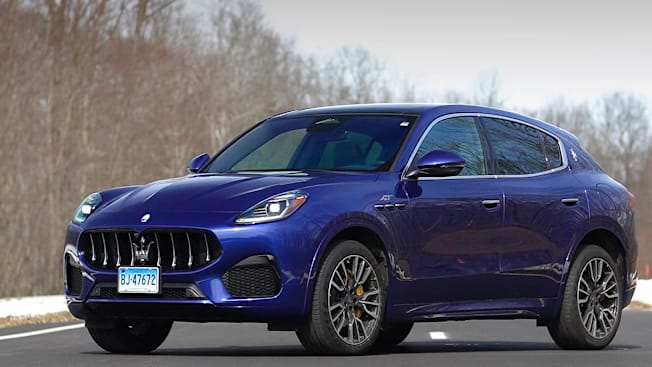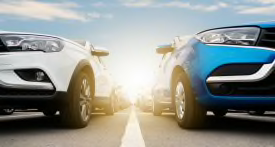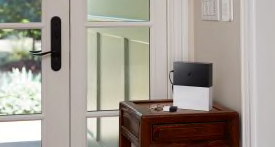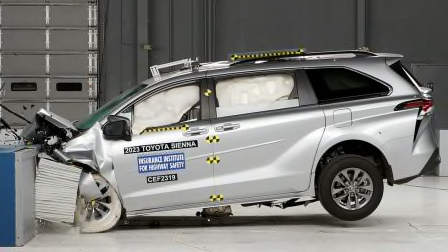Some Cars Will Never Be Crash-Tested, Leaving Consumers in the Dark
Big SUVs, luxury cars, and low-volume vehicles like the Tesla Cybertruck often lack publicly available crash-test scores

The Jaguar F-Pace, Land Rover Discovery, and Porsche Macan are all comfortable SUVs with extra trimmings and technology. Consumers can easily compare their fuel economy, 0-to-60-mph acceleration time, and cargo capacity. But when it comes to safety, consumers are left in the dark as to how they would hold up in certain crash scenarios. That’s because these vehicles have no publicly available crash-test ratings.
The same is true for the Tesla Cybertruck. Although Tesla has made bold safety claims about the vehicle and released its own crash-test footage, no independent data is available for car buyers to rely on.
Nearly a half-million passenger cars and SUVs sold each year have not been crash-test rated by the two main organizations that conduct independent assessments: the federal National Highway Traffic Safety Administration (NHTSA), which uses a star rating system, and the insurance industry-backed Insurance Institute for Highway Safety (IIHS), which rates vehicles from Poor to Good.

Photo: NHTSA Photo: NHTSA
What If the Car You Want Hasn't Been Tested?
For mainstream vehicles that are new to the market, buyers may have to wait for crash tests to be performed, IIHS spokesman Russ Rader told CR. For low-volume or luxury vehicles that have been on the market for years, Rader says that car buyers who are interested in a model without publicly available crash-test data should at least look up driver fatality rates and insurance claim losses by make and model, which can be found on the IIHS website.
"These resources show how vehicles are performing for safety in real-world crashes and include some vehicles that are not routinely crash-tested by independent testing organizations," he says. Rates for most cars are included, but there’s not enough data to determine rates for certain low-selling vehicles.
American consumers shouldn’t rely on ratings from safety agencies in other countries because protocols and safety standards can differ from country to country, and vehicles sold in other markets may have design differences that greatly affect their performance in crash tests even if those variations aren’t visible to the naked eye.

Jaguar Jaguar
A NHTSA spokesperson says the agency provides crash-test ratings for 86 percent of new vehicle models. In 2020, the IIHS crash-tested over 80 percent of mainstream vehicle models—which represents more than 97 percent of all passenger vehicles sold. Some vehicles that have not been crash-tested have been evaluated for child car seat fit, headlight visibility, rollover risk, or advanced safety features.
A NHTSA spokeswoman told CR that the vehicles the agency chooses are "a broad cross section that will help consumers make purchasing decisions about the vehicles that best fit their needs." Similarly, IIHS spokesperson Joe Young told CR that the group focuses on the most popular vehicles. "Our budget for crash testing vehicles is limited so we try to target big sellers," he says.
For example, neither NHTSA nor the IIHS have plans to test the Cybertruck. "While it has certainly created a lot of buzz, it’s unlikely we would invest resources to test it unless it were selling in numbers comparable with other popular large pickups," Young says.
David Friedman, a former NHTSA acting and deputy administrator who was also CR’s vice president of advocacy, said that although the agency might leave some vehicles out, focusing on top-selling cars is a wise move, considering that it pays for the cars it crash-tests, which can cost $10 million each year. For the most part, the IIHS also pays for the cars it tests.
"To fit in low-volume luxury cars would require either testing fewer cars that are more popular or taking money away from other life-saving efforts," Friedman said.

Photo: Consumer Reports Photo: Consumer Reports
All Models Must Meet Federal Standards
Even cars that lack public crash-test ratings from NHTSA or the IIHS must still meet minimum federal safety standards. In order to sell a new vehicle in the U.S., manufacturers must provide information from their own company crash tests to NHTSA to ensure compliance with federal standards. Some automakers, such as Mercedes-Benz, also told CR that they perform extra crash tests before introducing a new vehicle. "We often conduct up to 15,000 realistic crash simulations and about 150 vehicle crash tests to make an entirely new vehicle ready for customer operations," said a spokeswoman for Mercedes-Benz.
A spokesman for Porsche told CR that NHTSA and the IIHS determine which vehicles to test, that the automaker "rigorously designs and tests its vehicles to confirm they comply with" federal standards, and that those results are shared with NHTSA. A spokeswoman for Jaguar Land Rover did not respond to CR’s questions.
NHTSA also sometimes randomly tests vehicles that aren’t part of its regular five-star rating program—including some Alfa Romeo, Jaguar, and Land Rover models—to make sure manufacturers are in compliance with federal standards.
Manufacturers can request a crash test, too—which is why the IIHS tested the Maserati Ghibli sedan, Rader says. The agency has occasionally tested specialty vehicles, such as convertibles and hydrogen fuel-cell cars, to see how they perform in a crash. The IIHS will accept data from crash tests performed by manufacturers in certain cases—such as when the prior version of a model got a Good score—but the IIHS still audits a selection of those reports, Rader says.
In the case of the Cybertruck, Young says that Tesla could choose to nominate it for testing. "In that case we’d still procure the vehicles needed for testing, but Tesla would reimburse the cost," he says.
Ultimately, crashworthiness is one of the many important considerations buyers must take into account when purchasing a new vehicle, in addition to the available advanced safety features that may help prevent a crash from occurring.




















